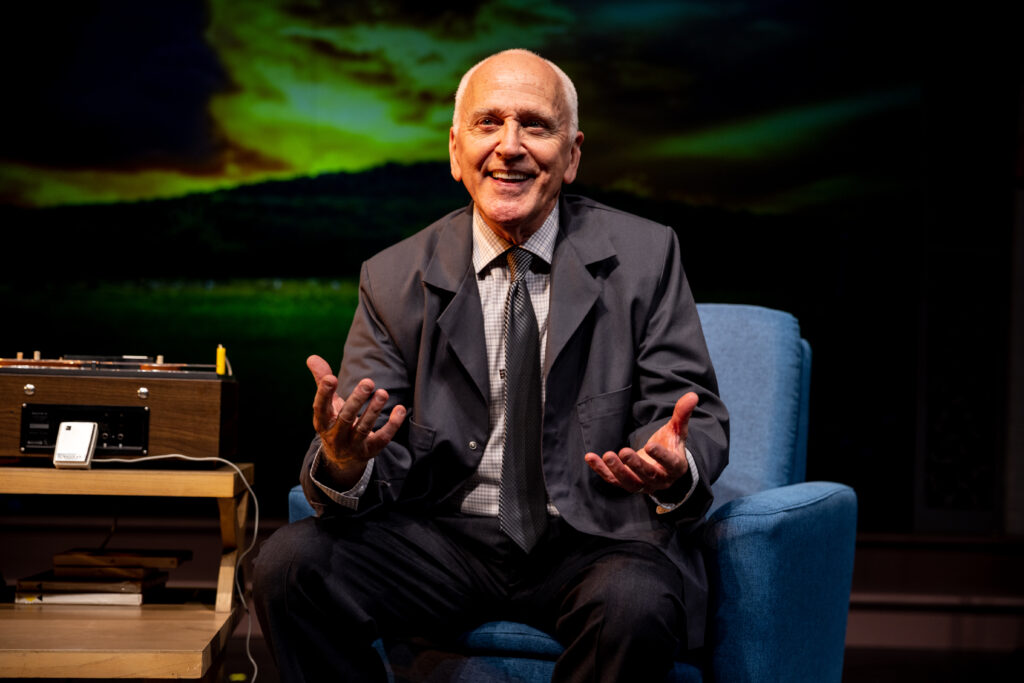Selective Memory
John Rubinstein gives a strong performance as Eisenhower in a one-man show that ignores darker truths.
BY CHRISTOPHER BYRNE

A play written primarily to burnish the reputation of President Dwight D. Eisenhower is inherently problematic for an LGBTQ+ audience. For all his heroism in World War II, one his earliest acts as President in 1953 was to sign Executive Order 10450, which banned homosexuals from working for the government or its contractors and resulted in the immediate firing of more than 5,000 employees on “suspicion” of homosexuality, provoking what became known as “The Lavender Scare.”
With this act Eisenhower codified and institutionalized anti-LGBTQ+ bias, ignorance, and hatred as official government policy for more than 20 years, damaged many lives, and validated the anti-gay conservative mindset whose impact is still felt today, most notably in a recent SCOTUS decision that fundamentally negated public accommodation laws with respect to LGBTQ+ individuals. And it all began because scaremongers thought LGBTQ+ people were dangerous, susceptible to blackmail, and would betray national secrets. Headlines of the time decried LGBTQ+ “perversion;” the closet was the only possible path for many, and the generational trauma this policy engendered in LGBTQ+ citizens can’t be sugarcoated. It can, however, be ignored, which is exactly what Richard Hellesen’s play Eisenhower: This Piece of Ground does.
The play is a one-man show with veteran actor John Rubinstein portraying the 34th President at home on his Pennsylvania farm in 1962. The gimmick (There always has to be one.) is that Eisenhower is recording his memoirs for a book on a tape recorder, allowing him to be alone in a room and talking at the same time. However, as the play opens Eisenhower has just seen a piece in the New York Times Magazine in which 75 historians have ranked him at number 22 among the Presidents in terms of effectiveness or import. It doesn’t matter so much, but it provides the catalyst for Eisenhower to launch into a defensive list of his accomplishments as both a General and President and convey bits and pieces of his biography. The result is not so much a play as a recital of events that launches itself at the audience as a lecture on one man’s effort to enlighten us about history as delivered by a curmudgeonly—but lovable—aging professor, and it often feels forced. (A common pitfall of the solo form.)
 Playwright Hellesen does, however, craft some effective moments. While Eisenhower continually proclaims how he values integrity and truth, his telling of his 1957 decision to send troops to force integration of the schools is on its face an act of nobility, but it is a largely political act. So, too, was his earlier response to the 1954 McCarthy anti-communism hearings—the “Red Scare” that came out of the “Lavender Scare” mentioned above. Rather than taking a stand, Eisenhower fears political backlash and so gives McCarthy “enough rope to hang himself.” At least, that’s what he says in hindsight. In truth, it was expediency rather than integrity that guided Eisenhower’s choices, and he seems oblivious to the lives and careers damaged in the process. Here, finally, there’s a hint of a play. We see a flawed man, dealing with an awareness of his shortcomings and battling with his legacy, but it only goes so far. Hellesen’s Eisenhower is quick to let himself off the hook again and again.
Playwright Hellesen does, however, craft some effective moments. While Eisenhower continually proclaims how he values integrity and truth, his telling of his 1957 decision to send troops to force integration of the schools is on its face an act of nobility, but it is a largely political act. So, too, was his earlier response to the 1954 McCarthy anti-communism hearings—the “Red Scare” that came out of the “Lavender Scare” mentioned above. Rather than taking a stand, Eisenhower fears political backlash and so gives McCarthy “enough rope to hang himself.” At least, that’s what he says in hindsight. In truth, it was expediency rather than integrity that guided Eisenhower’s choices, and he seems oblivious to the lives and careers damaged in the process. Here, finally, there’s a hint of a play. We see a flawed man, dealing with an awareness of his shortcomings and battling with his legacy, but it only goes so far. Hellesen’s Eisenhower is quick to let himself off the hook again and again.
Less successful are the more labored sequences in which Eisenhower describes the challenges of dealing with political extremism, which both surrounded the McCarthy hearings and drafting Eisenhower to run for the office. Hellesen has Eisenhower do everything but wink at the audience to ensure that they get the references to today.
Despite being limited by the stilted structure of the material, Rubinstein gives a solid performance as Eisenhower, though he’s required to be more a raconteur than an actor. To help out, somewhat, director Peter Ellenstein provides bits of predictable business—eating, drinking, phone calls—to keep Rubinstein moving about the stage, but he’s really just talking to the audience for two hours. Fortunately, Rubinstein has an easy charisma and solid stage presence with enough range and variation in the portrayal to be someone an audience actually wants to listen to, no matter arguments one may have with the material.
At the end of the play, Hellesen uses a device to show that forty years later a new crop of historians holds Eisenhower in substantially higher esteem when measured against the other Presidents. Though statistically meaningless, it is, perhaps, comforting to a contemporary audience who wants to see the Eisenhower years through a veil of gauzy nostalgia, in which “Ozzie and Harriet” represented life as it should be with its mid-century peace and stability. Hellesen’s play certainly panders to those folks. After all, they’re the ones still around to buy tickets.
Nonetheless, those mythic halcyon days, to the extent they existed at all, were exclusively for the white and heterosexual, and that’s exactly what many mean today when they say, “Make America great again.” So, it’s difficult to watch this play with that knowledge, knowing that outside the theater more than 520 anti-LGBTQ+ bills have been filed in our nation, and Eisenhower started it all. Looking back, for the LGBTQ+ people fired from their jobs under Eisenhower’s policy, labeled as deviants, and in some cases driven to suicide, America was not quite so great.
To be fair, Hellesen is free to interpret and express history as he chooses. Yet every audience brings their knowledge, lived experience, history, and, yes, biases, into the theater. If anything, this play stands as a reminder to LGBTQ+ people not to let others write our history—or write us out it.
Eisenhower: This Piece of Ground
Theatre at St. Clement’s
423 West 46th Street
Thurs, Fri, Mon 7 p. .; Sat 2 & 8 p.m.; Sun 3 p.m. through July 30
$55-$99 at OvationTix
1 hour, 50 mins, 1 intermission
Production Photos by: Maria Baranova
Published July 3, 2023









More Stories
Fall Arts Preview: Emus, Foxes and Eric Clapton, Too
Diane DiMassa Book Event September 25
Off-Broadway Review: Trophy Boys